- Hard Probes
- Heavy Flavor
- Jet-like correlations
- Other Groups
- Peripheral Collisions
- Spin
- Spin PWG
- Spin/Cold-QCD Older Physics Analysis
- 2006 EEMC Neutral Pion Cross Section and A_LL
- 2006 Gamma + Jet
- 2009 Lambda D_LL @ 200 GeV
- 2009 dijet x-sect/A_LL @ 200 GeV
- 2011 FMS Jet-like correlations @ 500 GeV
- 2011 FMS inclusive pions @ 500 GeV
- 2012 EEMC Neutral Pion A_LL
- 2012 Jet A_LL @ 500 GeV
- 2012 Lambda D_TT @200GeV
- 2012 Pi0 - Jet A_LL @ 500
- 2012 Pions in Jets A_UT @ 200 GeV
- 2012 dijet A_LL @ 500
- 2012/13 FMS A_LL @ 500 GeV
- 2013 Di-jet A_LL @ 500 GeV
- A New Users Guide to PDSF Success
- Analyses from the early years
- (A) List of Physics Analysis Projects (obsolete)
- Common Analysis Trees
- EEMC Direct Photon Studies (Pibero Djawotho, 2006-2008)
- 2006.07.31 First Look at SMD gamma/pi0 Discrimination
- 2006.08.04 Second Look at SMD gamma/pi0 Discrimination
- 2006.08.06 Comparison between EEMC fast and slow simulator
- 2006.09.15 Fit Parameters
- 2007.02.05 Reconstructed/Monte Carlo Photon Energy
- 2007.02.08 E_reco / E_mc vs. eta
- 2007.02.11 Reconstructed/Monte Carlo Muon Energy
- 2007.02.15 160 GeV photons
- 2007.02.15 20 GeV photons
- 2007.02.15 80 GeV photons
- 2007.02.15 Reconstructed/Monte Carlo Electron Energy
- 2007.02.19 10 GeV photons
- 2007.02.19 40 GeV photons
- 2007.02.19 5 GeV photons
- 2007.02.19 Summary of Reconstructed/Monte Carlo Photon Energy
- 2007.05.24 gamma/pi0 separation in EEMC using linear cut
- 2007.05.24 gamma/pi0 separation in EEMC using quadratic cut
- 2007.05.24 gamma/pi0 separation in EEMC using quadratic cut
- 2007.05.30 Efficiency of reconstructing photons in EEMC
- 2007.06.12 gamma/pi0 separation in EEMC at pT 5-10 GeV
- 2007.06.28 Photons in Pythia
- 2007.07.09 How to run the gamma fitter
- 2007.07.25 Revised gamma/pi0 algorithm in 2006 p+p collisions at sqrt(s)=200 GeV
- 2007.09.12 Endcap Electrons
- 2008.01.23 Endcap etas
- 2008.02.27 ESMD shape library
- 2008.02.28 ESMD QA for run 7136033
- 2008.03.04 A second look at eta mesons in the STAR Endcap Calorimeter
- 2008.03.08 Adding the SMD energy to E_reco/E_MC for Photons
- 2008.03.21 Chi square method
- 2008.04.08 Data-Driven Shower Shapes
- 2008.04.12 Data-Driven Residuals
- 2008.04.12 Pythia Gamma-Jets
- 2008.04.16 Jet Finder QA
- 2008.04.20 BUR 2009
- 2008.04.22 Run 6 Photon Yield Per Trigger
- 2008.05.07 Number of Jets
- 2008.05.09 Gamma-jets pT distributions
- 2008.05.19 Binning the shower shape library
- 2008.06.03 Jet A_LL Systematics
- 2008.06.18 Photon-jet reconstruction with the EEMC - Part 2 (STAR Collaboration Meeting - UC Davis)
- 2008.07.16 Extracting A_LL and DeltaG
- 2008.07.20 How to install Pythia 6 and 8 on your laptop?
- 2008.07.23 Hot Strips Identified by Hal Spinka
- 2008.07.24 Strips from Weihong's 2006 ppLong 20 runs
- G/h Discrimination Algorithm (Willie)
- Neutral Pions 2005: Frank Simon
- Neutral strange particle transverse asymmetries (tpb)
- Photon-jet with the Endcap (Ilya Selyuzhenkov)
- Relative Luminosity Analysis
- Run 6 Dijet Cross Section (Tai Sakuma)
- Run 6 Dijet Double Longitudinal Spin Asymmetry (Tai Sakuma)
- Run 6 Inclusive Jet Cross Section (Tai Sakuma)
- Run 6 Neutral Pions
- Run 6 Relative Luminosity (Tai Sakuma)
- Run 8 trigger planning (Jim Sowinski)
- Run 9
- Beam Polarizations
- Charged Pions
- Fully Reconstructed Ws
- Jet Trees
- W 2009 analysis , pp 500 GeV
- W 2011 AL
- Useful Links
- Working Group Members
2008.03.04 A second look at eta mesons in the STAR Endcap Calorimeter
Updated on Fri, 2010-07-16 11:03. Originally created by seluzhen on 2010-07-16 10:38.
Under:
A second look at eta mesons in the STAR Endcap Calorimeter
Introduction
In case you missed it, the first look is
. I processed
from the 2006 pp longitudinal 2 runs and picked events tagged with the L2gamma trigger id (137641). I ran the StGammaMaker on the MuDst files from these runs and produced gamma trees. These gamma trees are available at
/star/institutions/iucf/pibero/2007/etaLong/
. Within the StGammaMaker framework, I developed code to seek candidate etas with emphasis on high purity. The macros and source files are:
Note, the workhorse function is
StEtaFinder::findTowerPoints()
.
Algorithm
- Find seed tower with pT > 0.8 GeV
- Require no TPC track into the seed tower
- Get the ranges of SMD U & V strips that span the volume of the seed tower
- Find the strips with maximum energy within these ranges
- Require that the maximum strips have more than 2 MeV in each SMD plane
- Get the intersection of the maximum strips and ensures that it lies within 70% of the fiducial volume of the seed tower
- Make sure the photon candidate responsible for the SMD clusters above enters and exits the same seed tower
- Form a 11-strip cluster in each plane with +/-5 strips around the max strip and require that it contains 70% of the energy in a range +/-20 strips around the max strip
- Require that the energy asymmetry between the 11-strip clusters in the U and V planes be less than 20%
- Create a point using the energy of the seed tower and the position of the intersection of the max strips in the SMD U and V planes
- Repeat until seed towers in the event are exhausted
- Combine different points in the event to calculate the invariant mass
- Diphoton pairs with invariant mass between 0.4 and 0.6 GeV are saved to a PDF file
Invariant mass
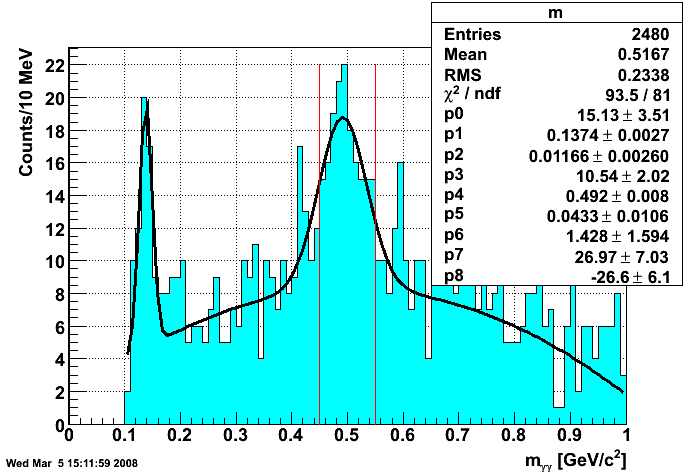
I fit the diphoton invariant mass with two Gaussians, one for the pi0 peak (p0-p2) and another one for the eta peak (p3-p5) plus a quadratic for the background (p6-p8). The Gaussian is of the form p0*exp(0.5*((x-p1)/p2)**2) and the quadratic is of the form p6*+p7*x+p8*x**2. A slightly better chi2/ndf in the fit is achieved by using Breit-Wigner functions instead of Gaussians for the signal here. I calculate the raw yield of etas from the fit as p3*sqrt(2*pi)*p5/bin_width = 85 where each bin is 0.010 GeV wide. I select candidate etas in the mass range 0.45 to 0.55 GeV and plot their photon response in the shower maximum detector here. Since we are interested in collecting photons of pT > 7 GeV, only those candidate photons with pT > 5 GeV will be used in the shower shape library. I also calculate the background under the signal region by integrating the background fit from 0.45 to 0.55 GeV and get 82 counts.
- S = 85
- B = 82
- S:B = 1.03:1
- S/√S+B = 6.6
Additional plots
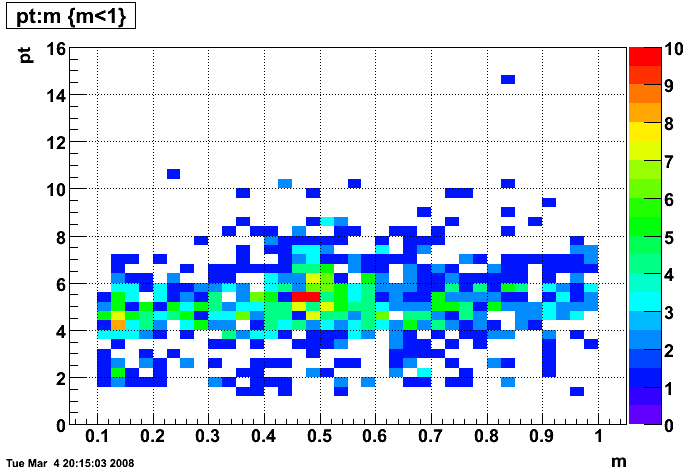
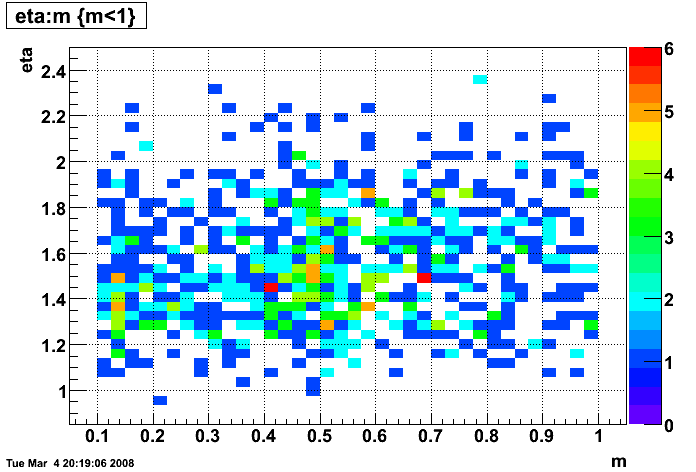
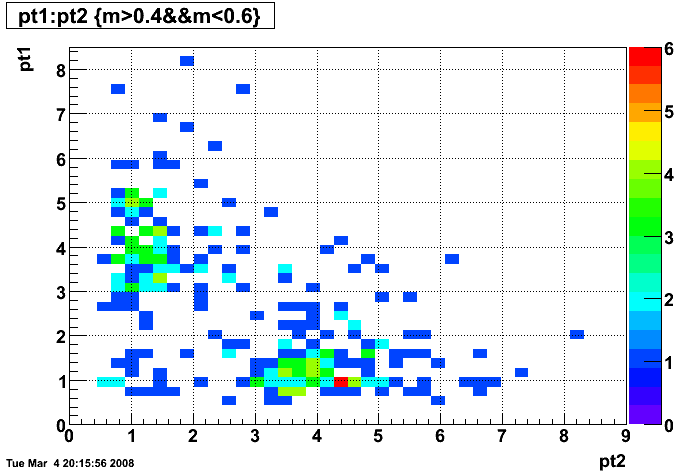
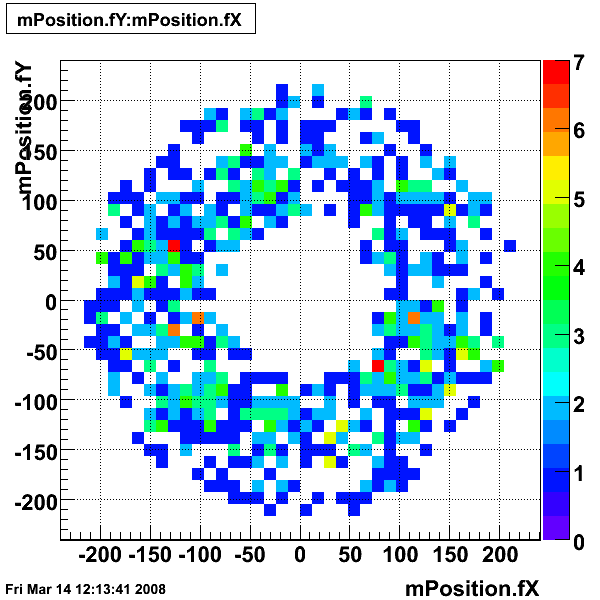
Pibero Djawotho Last updated at Tue Mar 4 16:21:13 EST 2008
»
- Printer-friendly version
- Login or register to post comments
